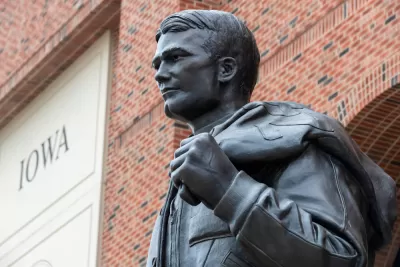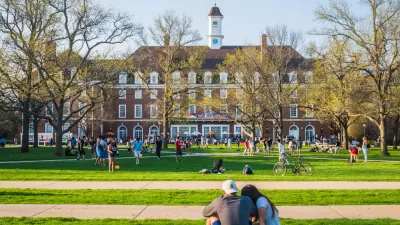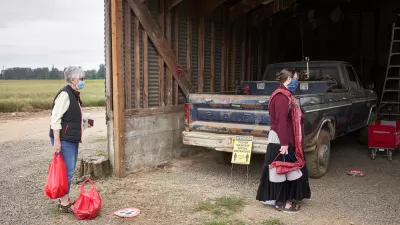College towns that have been observing public health guidelines and seen relatively few COVID-19 cases are now seeing infections spike as young people return to take classes. The New York Times has been tracking cases in colleges and college towns.

Four New York Times correspondents report on the tension in college towns throughout America where residents are concerned about threats to their public health posed by young people, the primary spreaders of the coronavirus, and also the needed economic stimulus to the local economy as campuses resume classes. The dateline for their deep-dive is Iowa City, home to the University of Iowa.
"Now, Iowa City is a full-blown pandemic hot spot — one of about 100 college communities around the country where infections have spiked in recent weeks as students have returned for the fall semester," write Shawn Hubler, Sarah Watson, Danielle Ivory and Robert Gebeloff on Sept. 6.
In a New York Times review of 203 counties in the country where students comprise at least 10 percent of the population, about half experienced their worst weeks of the pandemic since Aug. 1. In about half of those, figures showed the number of new infections is peaking right now.
Tracking college outbreaks
The New York Times launched a college and university Covid tracker on Sept. 3 that appears to be updated weekly. I updated the the college Covid case totals as of Sept. 10 in "[xx cases]" in the following paragraph.
As examples of college outbreaks affecting the counties in which they are located, the reporters point to Texas A&M University in Brazos County [1,042 cases]; East Carolina University in Pitt County, N.C. [1,025 cases]; University of South Dakota [242, note: no change since Sept. 3] and South Dakota State University [91, also, no change] in Brookings and Clay counties, respectively, and Illinois State University [1,327] in McLean County, Ill.
It’s unclear precisely how the figures [referring to infection data collected by the Times from both state and local health departments and individual colleges] overlap and how many infections in a community outside of campus are definitively tied to campus outbreaks. But epidemiologists have warned that, even with exceptional contact tracing, it would be difficult to completely contain the virus on a campus when students shop, eat and drink in town, and local residents work at the college.
The potential spread of the virus beyond campus greens has deeply affected the workplaces, schools, governments and other institutions of local communities. The result often is an exacerbation of traditional town-and-gown tensions as college towns have tried to balance economic dependence on universities with visceral public health fears.
Tracking metro/micro outbreaks
Another useful Covid tracker that the New York Times operates is "Monitoring the Coronavirus Outbreak in Metro Areas Across the U.S.", updated daily. It looks at four ways that the coronavirus is affecting metro/micro areas, the second being, "where the outbreak is worst now."
- Huntsville, Texas, home to Sam Houston State University with 259 Covid cases, located in Walker County, is #1 with 6.1 cases per 1,000 people in the last two weeks. Walker County leads the state with 619 new cases in the last week per 100k on Sept. 12, according to the Times' Texas tracker.
- Pullman, Washington, home to Washington State University with 263 cases, located in Whitman County, is #2 with 5.4 cases per 1,000 people in the last two weeks. Whitman leads the state with 537 new cases in last week per 100k according to the Times' Washington tracker.
"Public health experts say the rising number also underscores an emerging reality of the pandemic: Colleges and universities have, as a category, become hot spots for virus transmission, much as hospitals, nursing homes and meatpacking plants were earlier in the year," write Hubler and
Related in Planetizen:
-
September 1, 2020
-
August 28, 2020
-
June 29, 2020
-
September 12, 2019
Hat tip to Chris Hayes, MSNBC.
FULL STORY: A New Front in America’s Pandemic: College Towns

Alabama: Trump Terminates Settlements for Black Communities Harmed By Raw Sewage
Trump deemed the landmark civil rights agreement “illegal DEI and environmental justice policy.”

Planetizen Federal Action Tracker
A weekly monitor of how Trump’s orders and actions are impacting planners and planning in America.

The 120 Year Old Tiny Home Villages That Sheltered San Francisco’s Earthquake Refugees
More than a century ago, San Francisco mobilized to house thousands of residents displaced by the 1906 earthquake. Could their strategy offer a model for the present?

Ken Jennings Launches Transit Web Series
The Jeopardy champ wants you to ride public transit.

BLM To Rescind Public Lands Rule
The change will downgrade conservation, once again putting federal land at risk for mining and other extractive uses.

Indy Neighborhood Group Builds Temporary Multi-Use Path
Community members, aided in part by funding from the city, repurposed a vehicle lane to create a protected bike and pedestrian path for the summer season.
Urban Design for Planners 1: Software Tools
This six-course series explores essential urban design concepts using open source software and equips planners with the tools they need to participate fully in the urban design process.
Planning for Universal Design
Learn the tools for implementing Universal Design in planning regulations.
Clanton & Associates, Inc.
Jessamine County Fiscal Court
Institute for Housing and Urban Development Studies (IHS)
City of Grandview
Harvard GSD Executive Education
Toledo-Lucas County Plan Commissions
Salt Lake City
NYU Wagner Graduate School of Public Service





























